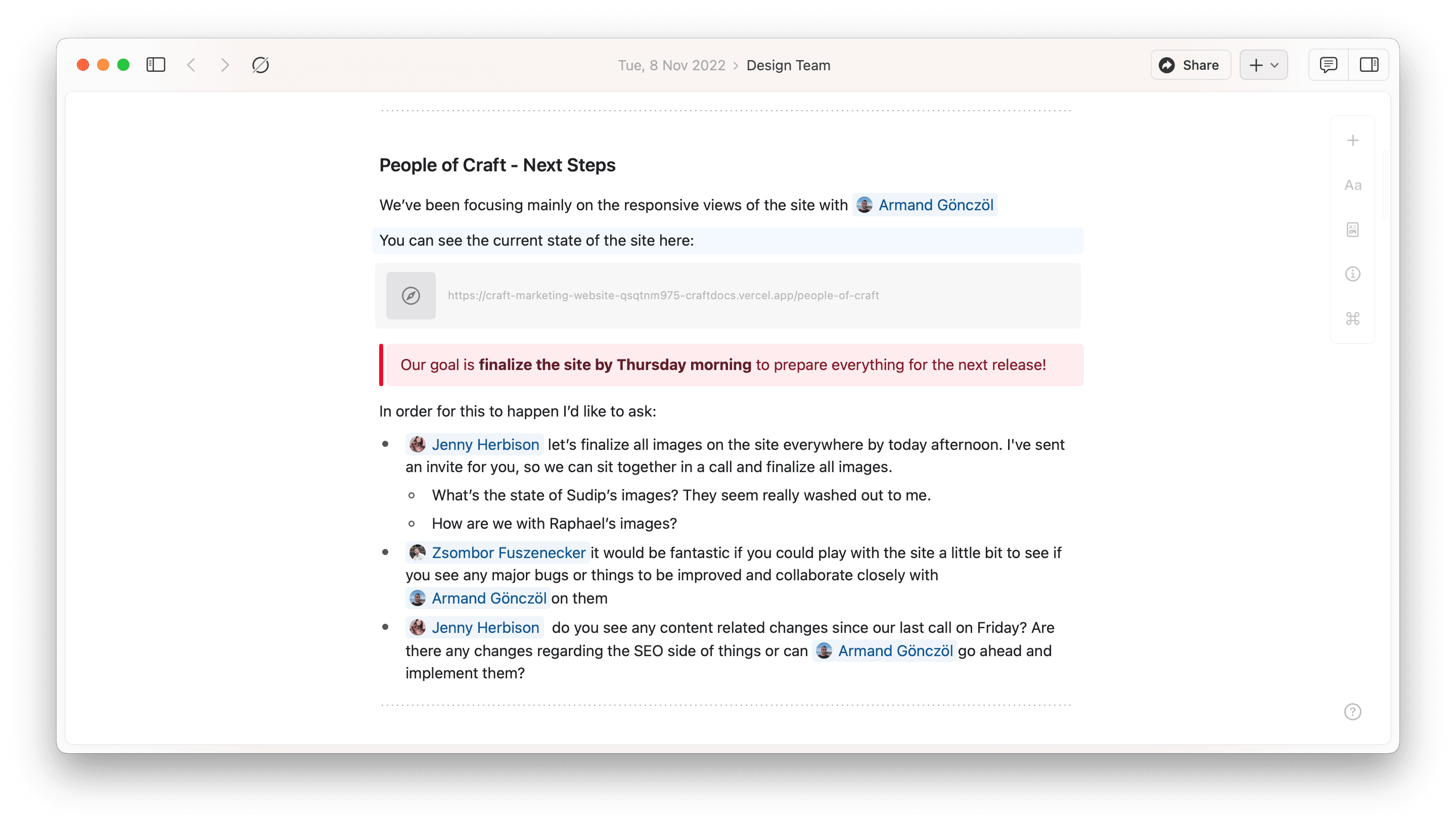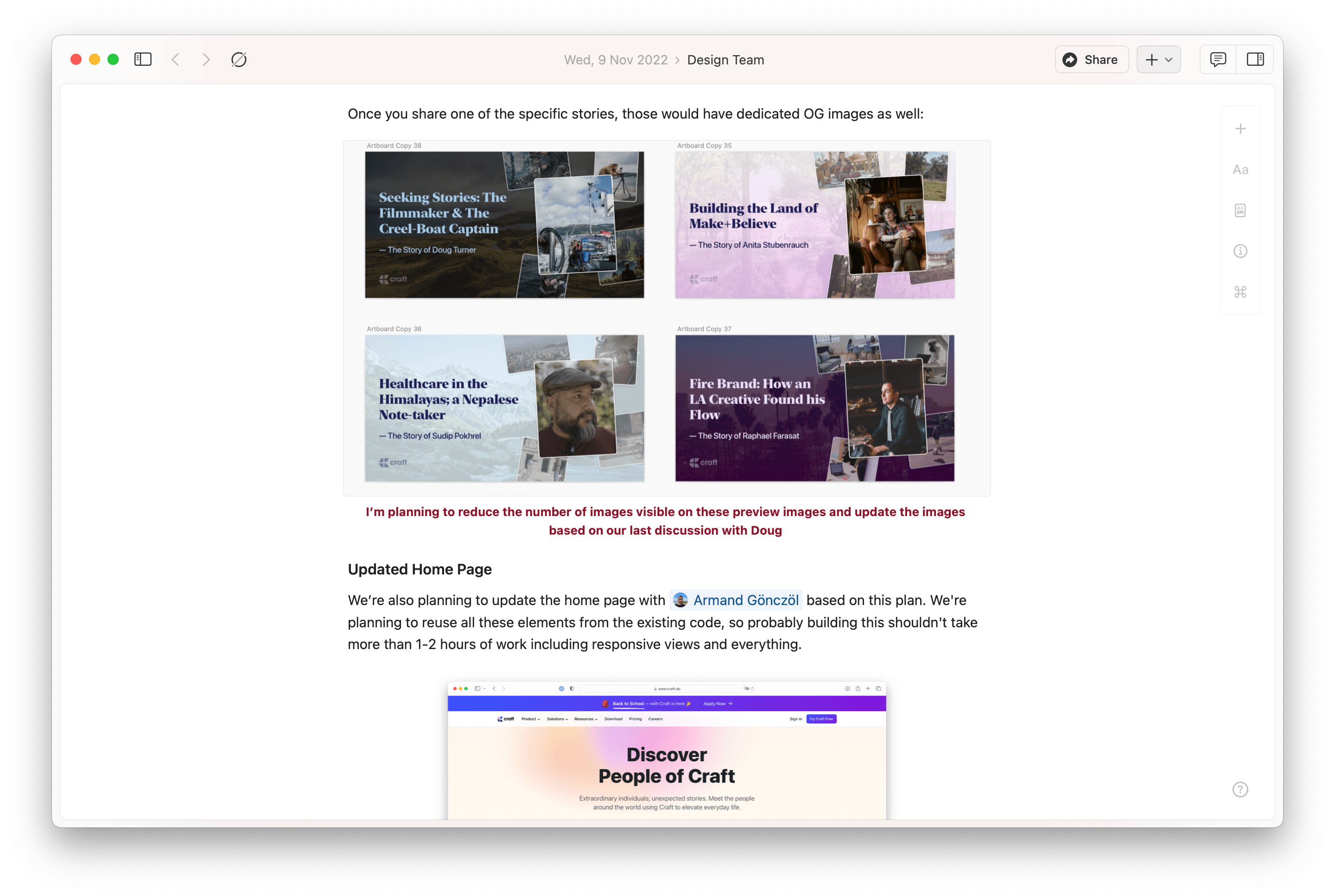How Daily Notes transformed our experience of remote work: Insights from Craft’s VP of Marketing
Discover how Craft’s VP of Marketing revolutionized remote work with the power of Daily Notes. Learn how this simple workflow fosters transparency, improves collaboration and enhances productivity in a hybrid work environment.


It should come as no surprise that we use Craft for almost all of our work. But what might be surprising is just how many tools and workflows it can actually replace. From engineering stand-ups to product launches, our team can ideate, collaborate, align, and execute all in one place. In this series, we’ll share how Craft’s features help us to create visibility, work asynchronously and stay aligned even when we’re distributed across the globe.
First up, Craft’s VP of Marketing, Jenny Herbison, shares how Daily Notes unlocked the full potential of async work.
The challenges of going hybrid
Being the first marketing hire at a fast-paced, hybrid start-up like Craft was always going to have its challenges but as someone used to working in a traditional office setting, the thing Jenny hadn’t bargained on was how much she would miss the casual, in-person interactions she experienced every day. Jenny was based in Edinburgh, while a large number of the team are in Budapest.
“It’s not about watercooler talk or chit-chat — though those are important too — it’s the fact that those fleeting conversations in the kitchen or drive-by decisions at someone’s desk create a shared context that makes working together with your team that much easier,” says Jenny.
“If I can quickly understand a colleague’s headspace or thought process, I know how to better manage what I’m asking of them. And it’s much easier to ask a difficult question or make the context of a conversation clear — for example, ‘I’m just thinking out loud’ vs ‘I really need a decision on this’.”
Daily Notes: a new way of working
This is not a unique problem, either — chances are you’ve made a similar transition to remote or hybrid working in the last few years and you’ve experienced this same lack of shared context.
At Craft, the team adopted a workflow — and later a feature —called Daily Notes, which in essence is as simple as it sounds. Each team member shares a structured, daily update detailing their progress and any obstacles from the day before as well as their plans for the following day, what made this even more unique was the depth of context added, including approach and thought process.
Jenny admits that she was initially unsure about how her team would feel about sharing Daily Notes.
“I didn’t want them to feel like they were being micro-managed and wanted to make sure they understood that Daily Notes weren’t just valuable for managers but also for the whole team.”
“A lot of this was based on my experience working in agencies where a similar practice exists but it’s deeply rooted in time management, efficiency, and billing.”
“When Balint explained the actual goal — to be more intentional about our communication so that we can close the gap created by our hybrid work model — I suddenly saw it through a really positive lens."
Embracing this cultural shift to be more open and vulnerable by sharing thoughts, first drafts, and early ideas became a revelation. Jenny learned to put alignment first, even if it meant sharing her thought process and “shitty first drafts”. This was a valuable transformation that helped Jenny to understand the real value of Daily Notes.
And that same mentality is embraced across all of Craft. Sharing regular detailed Daily Notes has helped to cultivate a culture of transparency, where team members can openly see what everyone is working on.
It also serves as a platform for acknowledging and appreciating each other’s contributions. This openness and recognition foster a sense of unity and motivation among team members.
“Of course, there were other challenges to adoption too. For example, marketing as a function is quite different from engineering or design workflows — there’s often much broader scope or more projects happening at the same time so figuring out how to present our Daily Notes in a valuable way took a little bit of time.”
“It was also initially tough to carve out time at the end of the day to actually write your update.”
Each member of the Craft team allows 20 minutes or so in their workday to write up their Daily Note — some folks do it throughout the day and others before they clock off. This provides an opportunity for them to reflect and plan for the following day while also sharing their progress and obstacles with others to read and feed back on.
“Once we figured out our rhythm, the value of Daily Notes dwarfed any of these initial concerns.”
Bringing this mentality to other workflows
Where Jenny felt it most keenly was in her weekly stand-ups with Balint, Craft’s CEO.
“The problem was, I was approaching meetings in the same way as I always had in the office environment — for this new world of working, I was doing meetings the wrong way”, says Jenny.
“Our weekly 1:1s were short so, of course, we prioritized work, blockers, and reporting but it felt like something was missing.”
Jenny decided to start approaching the weekly 1:1s with the same mindset she did the Daily Notes. Throughout the week, she contributes to her Weekly Notes with updates, action items, and blockers as well as valuable discussion points, early ideas, and notes about her thought process. In return, Balint can use the same note to share his thoughts on more difficult decisions, problem-solving, and priorities. This also means, when it comes to their weekly meeting, they already have a list of prioritized agenda items, and anything that isn’t important enough to fit into the call is addressed asynchronously.
“It increased the speed at which we could make decisions, aligning before the weekly call on some decisions through the async doc, and giving us the opportunity to take longer in the meeting to discuss necessary areas in depth.
It bridged the communication gap created by the lack of in-person interactions and played a huge role in recreating that sense of connection. These async interactions helped us both to understand how the other person was thinking and took our working relationship to another level, with deep foundations of understanding and collaboration.”
Supercharging cross-functional collaboration
During the People of Craft project, which brought some customer stories to life in a microsite, Jenny realized the true potential of Daily Notes in cross-functional collaboration.
“Product engineering, design, and marketing could all share their updates and context in one space. The team could tag each other, share action items, and context, and seamlessly move tasks forward. This is something that just wasn’t possible when people and information were spread out across multiple tools.”

Cross team collaboration during the People of Craft project

Daily updates on progress and next steps
During these larger-scale projects, Daily Notes played a pivotal role in maintaining an archive of the team’s decisions and progress. Because each Daily Note is connected to a calendar date, it became easier for the team to refer back to previous discussions or decisions whenever necessary. This historical timeline was invaluable for retrospective analyses, learning from past experiences, and making informed decisions for future planning.
Unlocking fast feedback loops
“With launch deadlines looming and new deliverables and dependencies turning up mid-project, one of the most powerful impacts of Daily Notes was how much it sped up the feedback process.”
By sharing thoughts and progress regularly, team members could provide almost instant feedback and they had enough context that the feedback was always valuable. This reduced the time wasted in lengthy revision cycles, stopped anyone from getting blocked, and improved the team’s efficiency.
Adapting to the teams’ needs
Daily Notes also proved to be incredibly flexible and adaptable, which made it easy for Jenny and her team to incorporate them into their evolving workflow. Regular updates could be easily customized according to the project’s needs, and links to resources like Figma mockups or Linear tickets could be included to provide extra context where needed.
Whether it’s a bulleted task list, a graph or an image, or a short paragraph, the flexibility to tailor Daily Notes to the unique requirements of different tasks and teams was a game-changer.
Daily Notes can work the way you do
This flexibility of Daily Notes is really its superpower because it means you can achieve the same visibility and efficiency we have with any kind of team, workflow, or process.
At Craft, different teams have even adapted Daily Notes to better suit their needs. Some teams use them to supplement a daily stand-up or a 1:1 with detailed notes and discussion points that can be shared before the call. Others have used them to replace some meetings altogether — after all, why schedule an expensive call when you can make decisions in a doc?
Daily Notes also work great for weekly or monthly calls where shared context might be lost during the lengthy gap between meetings.
Just as Jenny overcame her initial reservations by adopting a new approach to working, it's important to stress that embracing a cultural shift in communication and working style was a crucial part of making Daily Notes work at Craft.
The team has learned to value open channels and be vulnerable by sharing not just polished final products, but also the rough work. This openness led to richer collaboration and a better understanding among team members.
“I would find it really difficult to work somewhere that doesn't work like this”
While that kind of cultural change is not an overnight process, Daily Notes are a great first step towards fostering a more open and transparent workplace, and they’ll help provide better alignment and visibility across your team instantly.
Elevate your team’s workflow with Daily Notes
For Jenny and her team, Daily Notes revolutionized the way they work in a hybrid environment. They bridge communication gaps, foster a culture of transparency and recognition, facilitate cross-functional collaboration, and create visibility for everyone on the team.
For organizations looking to enhance team alignment, improve collaboration and boost productivity, Daily Notes offer a totally flexible workflow that’s accessible to anyone.
You can try using Daily Notes with your team for free. It’s an ideal way to experience the power of Craft and, if you need some help getting started, we even have a collection of free Daily Notes templates to suit all kinds of teams and workflows.